Greetings everybody,
This edition of The Sewing Machine Newsletter is Part 3 of my article series on the sewing machine landscape as it stands in 2024. In Part 1 we briefly discussed the destiny of a handful of iconic 20th century European sewing machine manufacturers (Singer, Pfaff, Viking, Elna, Necchi). In Part 2 we discussed the Swiss company, Bernina. Part 3 is all about Janome, a Japanese sewing machine manufacturer who seems to fly under the radar of the general sewing community. As you’ll see, I am a big fan of Janome for a handful of different reasons.
Reliability
My father is both the owner and head technician of The Sewing Machine Shop. He has been selling and fixing machines for over 30 years. You can imagine, for a man in his position, it is disheartening to sell someone a machine, then see it back on your repair bench soon after the sale with a defective part or manufacturing error that you now have to fix. Unreliable machines are not good business, plus they are a pain to repair. Therefore, during his 30 years in the business, he has sifted through the sewing machine landscape and stopped selling certain brands altogether that he comes to view as unreliable. He is truly the G.O.A.T. when it comes to sewing machine repair, and about once a year I ask him the same question: “Gun to your head, if you had to pick the most reliable sewing machine manufacturer in the world, who would you pick?” His answer is always the same: Janome.
When comparing all the different sewing machine manufacturers, our experience is that Janome-built machines have the fewest number of electronic/computerized issues. This is something I value because we are deep into the era of computerized sewing machines. While computerized machines offer a ton of awesome features, they are only good if the electronics are reliable. I feel confident when I say that nobody has more reliable electronics than Janome. To be clear, we are big fans of sewing machines made by other manufacturers such as Bernina, Brother, and Baby Lock. It is rare to see electronic issues on any of these machines, but it is the most rare to see such issues with Janome.
In my eyes, reliability is a twofold concept in the sewing machine world. Not only are Janome machines built with high-quality electronics and hardware, but they are also designed in such a way that does not lend themselves to user error. I cannot stress the importance of this enough— a machine designed to reduce user error is a more reliable machine. Whenever a machine is brought into the shop with a problem, I’d guess that 75% of the time that problem is caused by user error. This is nobody’s fault— sewing machines are complicated with little room for error, especially when threading the machine and winding the bobbin. I believe the engineers at Janome understand this, which is why they make sure to design their machines to be user-friendly. For example, all Janome machines are designed so that the user can easily see the takeup lever and visually confirm it is properly threaded in the takeup lever eyelet. Not all manufacturers do this. Please read a previous article titled Avoiding Traumatic Events to learn why this small design detail is so so so soooo important.
Cost Effective
Another reason I love Janome is because their machines tend to be super cost-effective. There are certain price points where Janome offers such a good product for the money one is spending that I personally feel bad selling someone another brand’s machine at the same price point.
For example, Janome makes the best sewing machines for under $500. My dad and I recently had a conversation about it and were laughing about how rare it is for a customer to be dissatisfied with their <$500 Janome machine. It’s hard to be upset when you spend $300 on a machine and the machine lasts you 15-20 years without ever breaking down. But don’t take my word for it. Look at some other sewing machine brands, such as Baby Lock and Juki. The Baby Lock Joy is a $249 basic mechanical machine that is incredibly well-built. Through some sort of cross-manufacturing partnership, the Joy is made by Janome for Baby Lock. Same deal with Juki, which is primarily an industrial sewing machine company, but also has a home sewing machine division. Two of their most popular entry-level machines are Juki HZL-LB5100 & Juki HZL-LB5020, both of which are high-quality Janome-built machines for under $500.

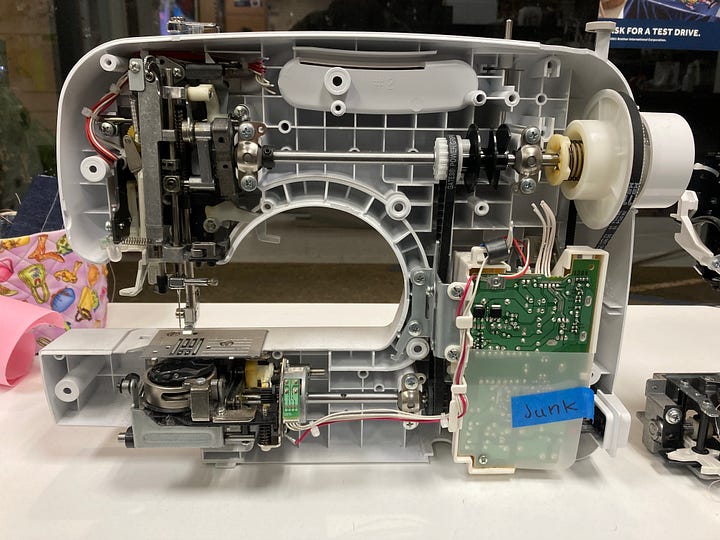
But it’s not just machines under $500. The price point of $1,000-$2,500 is another area where Janome dominates because of their Janome Skyline series.
Sewing machine companies throw around the words “heavy-duty” rather loosely for marketing purposes. However, the Skyline series appears to be the least expensive machine that is actually designed with heavy-duty internal components. The Skyline S5 gives you this heavy-duty platform for ~$1,200. The Skyline S6 is built on that same platform, plus you get Janome’s Acuflex walking foot. This feature makes the S6 extremely cost-effective because I would argue the Acuflex walking foot is the best walking foot in the world. Janome puts it with their top-of-the-line machines like the M8 and M17— they also put it with the ~$1,500 Skyline S6. A walking foot designed with integrated dual feed for such a low price is unheard of. I love Bernina and I love Brother, but to get their version of integrated dual feed you have to fork out more than twice the money that you pay for the Skyline S6.
The same goes for the pivot/hover feature. Janome gives you pivot/hover on the Skyline S7, which is ~$2,400. A Bernina machine with pivot costs $4,000+.
The same goes for throat space. The Janome MC6700 is in the ballpark of $2,500-3,000 and gives you 10 inches of throat space. Contrast that with Bernina, who gives you 10 inches of throat space once you hit the 7 series. Brother and Baby Lock machines with 10+ inches of throat space also cost quite a bit more.
Again, I just want to reiterate that I love Bernina, Brother, and Baby Lock machines. However, a big strength of Janome is that their machines are extremely cost-effective at certain price points. If you want 10 inches of throat space for your quilts, Janome offers the least expensive option. Want an integrated walking foot? Janome offers the least expensive option. Want a machine with premium internal components that are truly heavy-duty? You get the picture. These are high-quality machines equipped with awesome features at affordable prices.
Top-Tier Performance
What about the true top-of-the-line sewing machines?
About 5 years ago Janome released a machine called the the Continental M7. About 2 years ago, they released the Continental M17, a sewing embroidery combination machine. Then this past October they released the Continental M8, the first home sewing machine other than Bernina to come with stitch regulation for free motion sewing. The existence of these 3 machines altered the sewing machine landscape forever.
The M7, M8, and M17 are all built on the same platform, one that is quite unique amongst home sewing machines. Instead of the traditional free-arm that most home sewing machines are designed with, the Janome M-Series are all flatbed machines. In addition to the flatbed design, they all have 13.5 inches of throat space, which is by far the largest throat space in the home sewing machine industry.
As we talked about in the Sewing Machine Skeleton article last week, the bottom half of a sewing machine contains the lower shaft, the hook mechanism, the feed dog mechanism, and the auto trimming mechanism. On a free-arm machine, all these internal components must be oriented in a way so that they can fit inside the machine’s narrow free-arm. But there is not freearm on a flatbed machine like the M7. Therefore, the engineers do not have to compromise the size and placement of these critical internal components. More room means the engineers can afford to bulk up these components and not compromise due to spacial restrictions. The result is a more powerful, sturdier machine.
As you can see in the photos below, the metal housing of these machines is impressive:
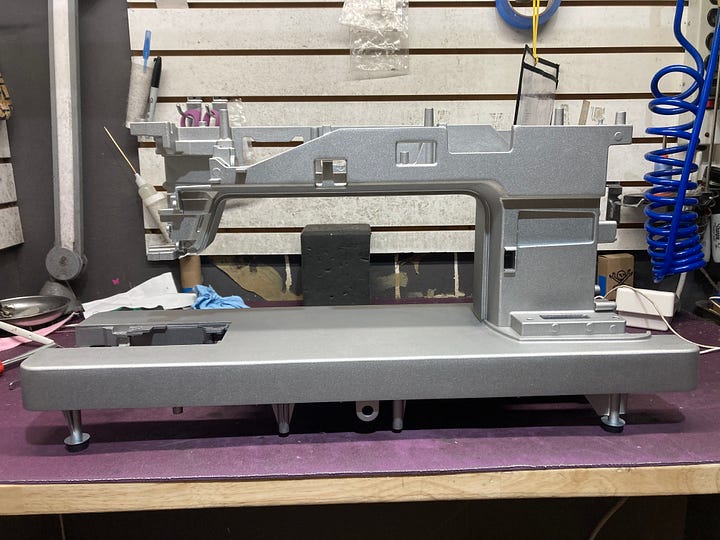
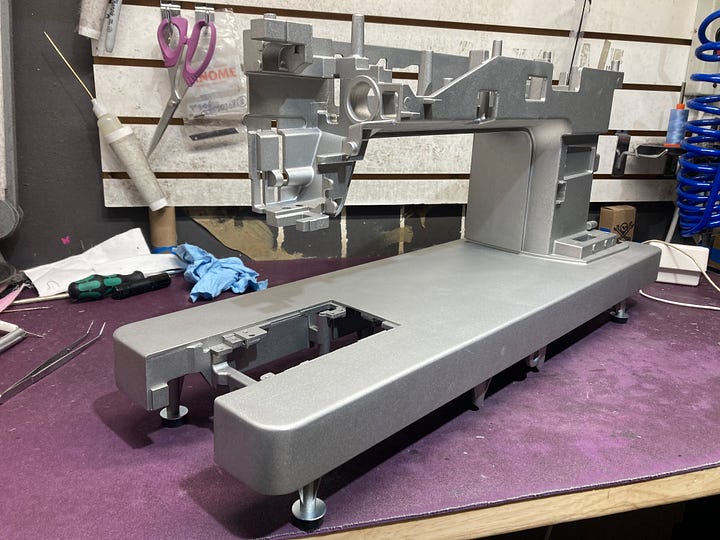
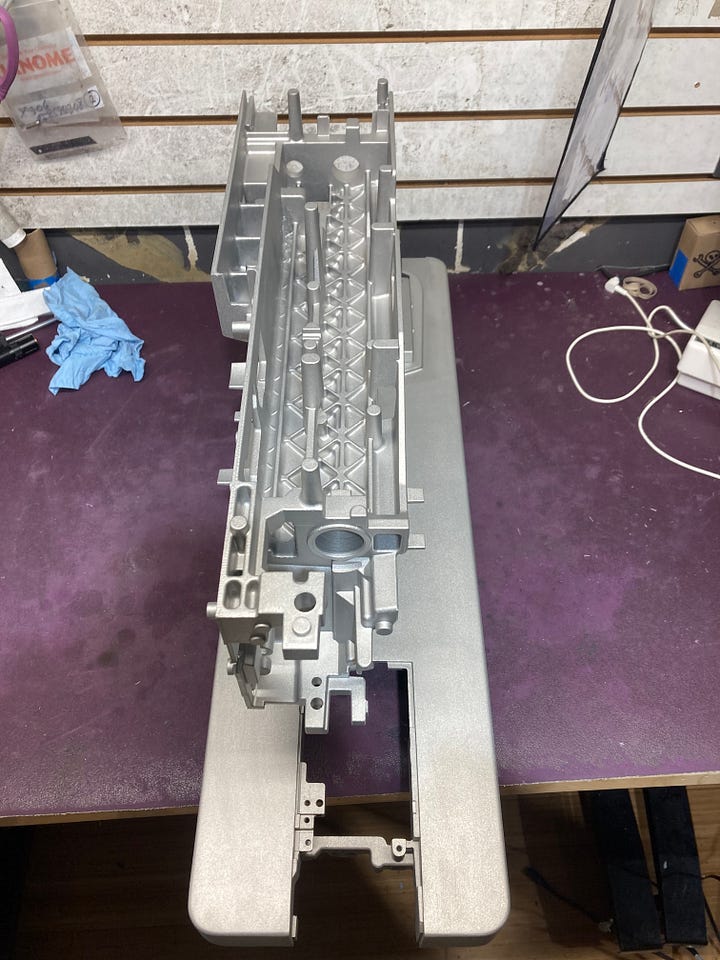

The touch and feel of the M-series machines are incredible. The massive footprint of the machine combined with the flatbed design and all that metal supporting the internal components creates an extremely heavy and sturdy feel for the sewist. On top of all that, Janome equips these machines with an industrial-grade brushless servo motor. The M7, M8, and M17 are the only home sewing machines equipped with such a motor. Not only is this type of motor quite powerful, but because there are no motor brushes, the motor is far less likely to wear down over time.
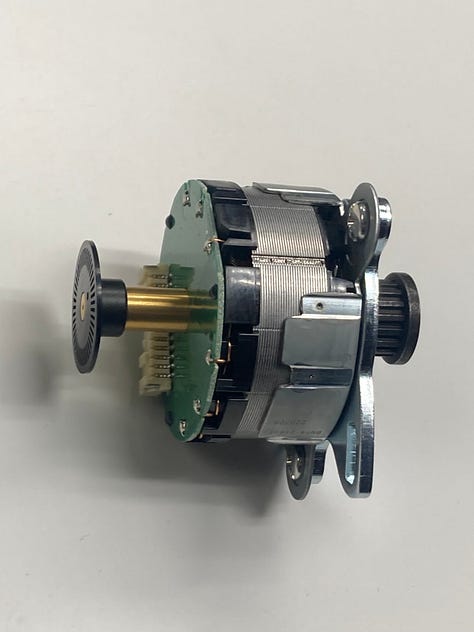
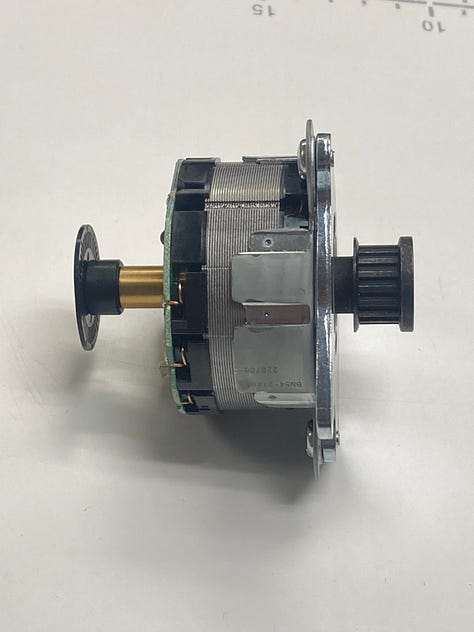
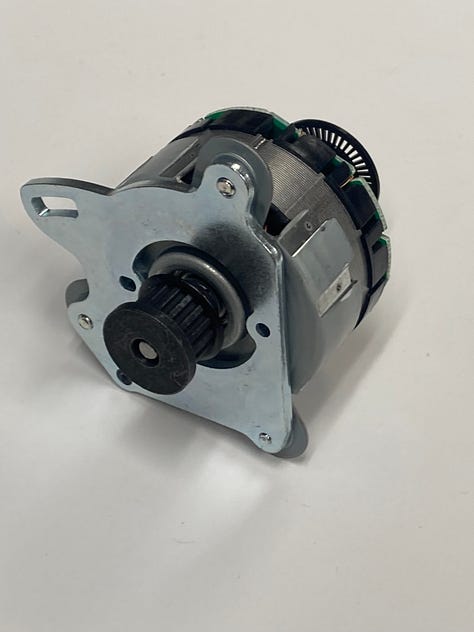
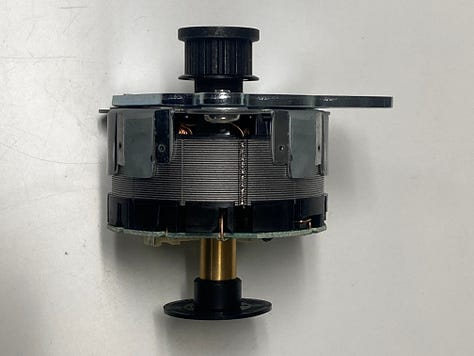
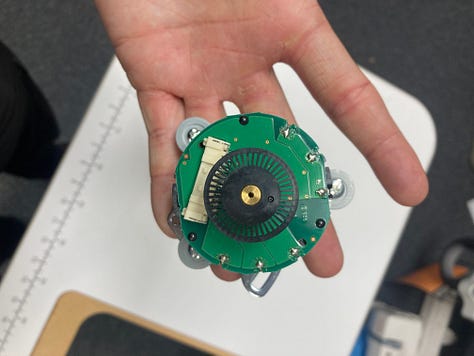
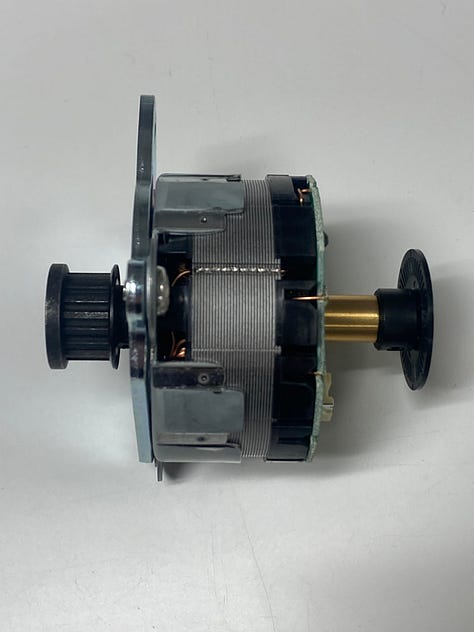
As someone who started out as a sewing machine technician, obviously I geek out on stuff like the housing of the flatbed platform and the motor. However, the reason I love these M-series machines so much is because the sewists I have sold them to love them even more. The are easy to use. They are extremely reliable. The touch and feel when sewing is second to none, plus the stitch quality is exceptional. Everyone appreciates the mind-boggling 13.5 inches of throat space. Quilters love the Janome stitch regulator for free motion quilting (which comes with the M8 and M17, not the M7). Garment makers who learned on industrial machines in fashion school love the heavy feel and power of the flatbed design and brushless servo motor. Janome truly raised the bar with this series of top-of-the-line machines. I would argue that these are the best home sewing machines ever made.
I’ll be the first to admit that I am biased toward Janome. I love the products they make and I wholeheartedly believe that it should be a more popular brand among sewing machine enthusiasts. Why they seem to fly under the radar of the general sewing community, I can only speculate.
The next part of the sewing machine landscape article series will cover Brother and Baby Lock, two interconnected sewing machine brands. Brother’s true strength is embroidery. Baby Lock’s true strength is sergers. Stay tuned.
Thank you for reading,
-Cale

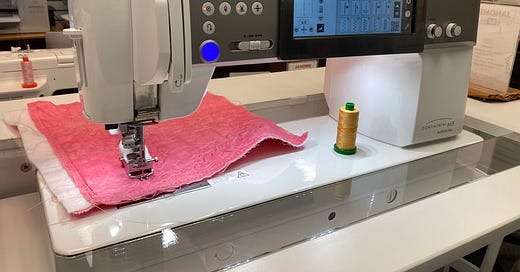



I love this series! Thank you so much. As a fifty year diehard Bernina fan, i am slowly opening my eyes to other brands. My dealer that has been an excellant repair guy over the years, recently informed me that due to the design of my beloved old Bernina coverstitch, there is no way to adjust the loose slanted bar causing it to slowly start skipping stitches, especially on seams, so i I had to trash it. I literally wore it out. I never thought i would see the day. He sells several brands, but highly recommended a sturdy Janome coverstitch, for the same reasons as you, it is affordable, but well made and reliable, never seeming to fail in the years he has been selling and repairing. There was a lightly used one on the floor that i bought, it seems to work fine, marching fearlessly over lumpy french terry seams. And is so much easier to thread, i had a two minute tutorial at the check out, it seemed too good to be true.
Years ago I had purchased a used Bernina 830 E, but although working, it was so finicky and sensitive, i finally got rid of it because i was always ending up mad every time i tried to use it. Technically it sort of worked, but was so glitchy and problematic, just simply threading it, also several random error messages resulted in it being sent away no charge and fixed by Bernina. But it was too late, i was defeated, it took all the fun out of sewing. I got rid of it and replaced it with nothing.
Then my trusty 1530 Bernina started acting up, randomly freezing and changing stitches in the middle of a seam, i panicked and bought a new Bernina 580 because he said he couldn’t get electronic parts for the 1530, so couldn’t guarantee he could keep it going next time it balked. I kept it as the incidences were random. It turned out my little sewing studio was getting too cold in the winter. Minus 40 Celsius last night, so only getting up to 13 degrees this morning inside. Once i warm up the 1530 on the floor, in front of the electric fan heater, it seems to behave, which is good because the the 580 is not intuitive, and won’t even wind a bobbin without my assistance, and the throat plate has to be changed back and forth constantly, the hole is so big i can’t use the gathering foot. I need two machines to make any progress garment making! Just removing the bobbin holder i have to twist my arm around uncomfortably, as it faces the wrong way, i am right handed, but have to contort to grasp the tiny lever. And if i use the upright thread holder it doesn’t like it, so another step to thread. And the automatic needle threader is random, it takes several tries.
Long term too, in my experience, it feels like Bernina computer software becomes obsolete too soon in my books, and then parts become unavailable, is that the same with all brands? I dunno. I love the auto thread cutter, on the 580, and try to use it, but really, i still love my 1530 best. Perhaps i could drape a heating pad over the old girl? It is like she has arthritis. Lol.
So i look forward to your article next week as i am almost ready to throw in the Bernina towel. Lol. My friend had the Bernina 1630 for years and it was sensitive and always out of wack and needing servicing. She hated it, near the end it was declared unfixable. She had all but quit sewing by that time. She finally bought a new Babylock serger and new Babylock sewing machine and is having so much fun, she loves them so far! I forget the model numbers. She is getting older and her hands shake so she loves the air threading.
I love your articles, i learn so much. I have a lot of respect for all repair guys, when they talk i listen! Thank you so much. Fascinating.
I'm disappointed that my local sewing machine store doesn't carry Janome. I would have loved to try one of these, but alas, it's not in the cards. I recently purchased a Bernina 590 and while it sews beautifully, it's temperamental. I'd love an "always reliable, always does what you ask," machine. While the stitches on the 590 are gorgeous, they come with a price -- frequent oiling (it quite literally drinks oil), and cleaning. After only a month, I'm sick of having to oil and clean the innards (the hook), before sewing a stitch. Must my 2 cents. In Massachusetts -- local dealer is in New Hampshire.